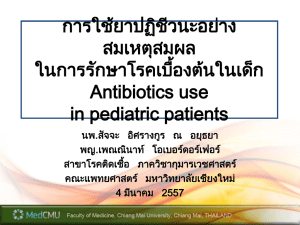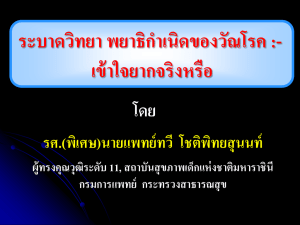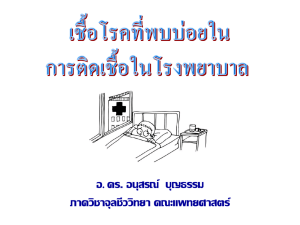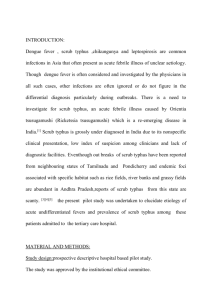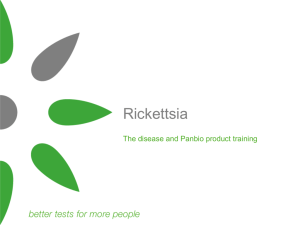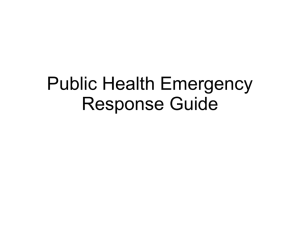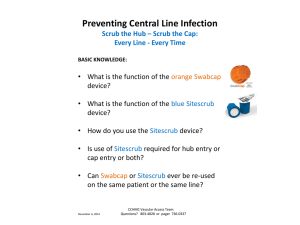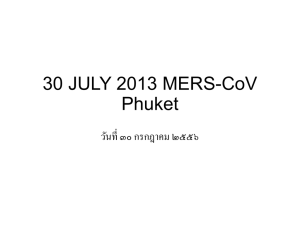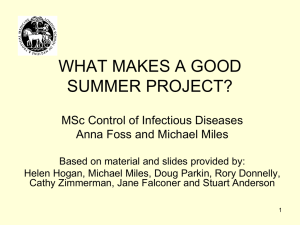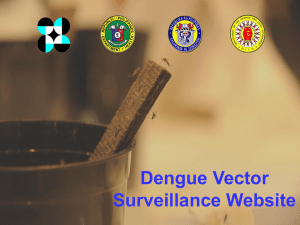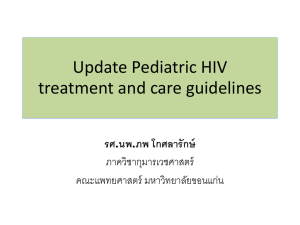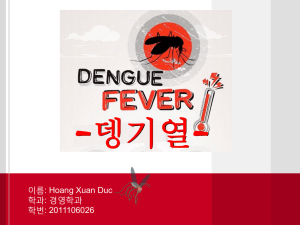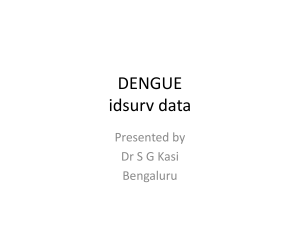ไข้เฉียบพลัน (Acute febrile illness)
advertisement
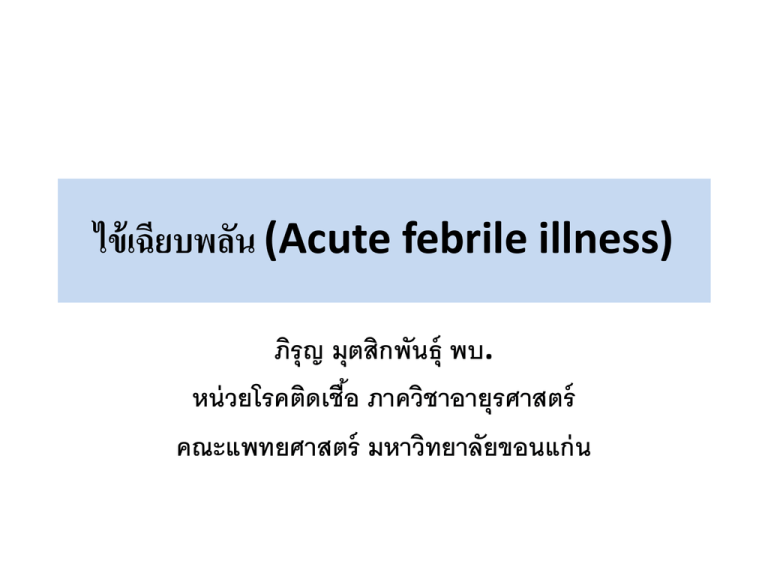
ไข้ เฉียบพลัน (Acute febrile illness) ภิรุญ มุตสิกพันธุ์ พบ. หน่ วยโรคติดเชือ้ ภาควิชาอายุรศาสตร์ คณะแพทยศาสตร์ มหาวิทยาลัยขอนแก่ น เนือ้ หา • ความหมายและสาเหตุของไข้ เฉียบพลันโดยทั่วไป • สถานการณ์ และระบาดวิทยาของไข้ เฉียบพลันในประเทศ ไทยและพิษณุโลก • โรคติดเชือ้ ที่ทาให้ เกิดโรคไข้ เฉียบพลันพบบ่ อย - อาการทางคลินิก - แนวทางการวินิจฉัยและรักษา นิยามของไข้ เฉียบพลัน (Acute febrile illness) • ไข้ – อุณหภูมิร่างกาย > 38.3 C • เฉียบพลัน (acute) – ระยะเวลาที่มีไข้ ไม่ เกิน 7-14 วัน • กึ่งเฉียบพลัน (subacute) – ระยะเวลาที่มีไข้ 14- 21 วัน • เรือ้ รัง (chronic) – ระยะเวลาที่มีไข้ > 21 วัน สาเหตุของไข้ เฉียบพลัน • โรคติดเชือ้ พบมากที่สุด มากกว่ าร้ อยละ 90 • โรคแพ้ ภมู ิตนเอง (autoimmune dis) • โรคมะเร็ง (malignancy) • โรค hyperthyroid • แพ้ ยาหรือสารพิษ โรคติดเชื้อทีเ่ ป็ นสาเหตุของไข้ เฉียบพลัน • การติดเชือ้ เฉพาะที่ (focal infection) • การติดเชือ้ หลายตาแหน่ ง ที่ย้อมพบหรือเพาะเชือ้ ก่ อโรคได้ (multifocal or disseminated infection) • การติดเชือ้ ที่มีอาการหลายระบบ ที่ย้อมไม่ พบหรือเพาะเชือ้ ไม่ ได้ (systemic infection) การติดเชื้อเฉพาะที่ที่พบบ่ อย โรคติดเชือ้ ตามระบบ ตัวอย่ างอาการ ตัวอย่ างอาการแสดง URI ไข้ เจ็บคอ นา้ มูก Injected tonsils Pneumonia ไข้ ไอ หอบ มีเสมหะ Lung - crepitation Endocarditis ไข้ หอบ บวมนา้ New murmur Peritonitis ไข้ ปวดท้ อง Diffuse tender Skin soft tissue infection ไข้ ผื่น ผิวหนัง Urinary tract infection Pustules, vesicles, bleb ไข้ ปั สสาวะ แสบขัด ขุ่น CVA - tender การติดเชื้อเฉพาะที่หลายตาแหน่ ง โรคติดเชือ้ ตัวอย่ าง Staphylococcus dissemination Lung, joint, brain Melioidosis Lung, joint, liver & spleen (Burkholderia pseudomallei) การติดเชื้อทีม่ ีอาการหลายระบบ (systemic infection) • มี constitutional symptoms เด่ น – ไข้ ปวดเมื่อยตาม ตัว ปวดข้ อ อ่ อนล้ า • ตรวจร่ างกาย ไม่ พบความผิดปรกติเฉพาะที่ใดชัดเจนหรือมี ผิดปรกติหลายตาแหน่ ง มีผ่ ืนผิวหนังแบบ maculopapular หรือ eschar • ผลตรวจทางห้ องปฏิบัตกิ าร - ไม่ จาเพาะ • ไม่ พบฝี หนอง ในตาแหน่ งที่ตดิ เชือ้ ย้ อมสารคัดหลั่งไม่ พบเชือ้ • เพาะเชือ้ ไม่ ขึน้ ใช้ การตรวจ serology ในการวินิจฉัย Systemic infection • • • • • • Leptospirosis Rickettsiosis (scrub typhus, murine typhus) Enteric fever Malaria ก่อนจะตรวจเลือดพบเชื ้อ malaria Dengue fever ก่อนจะตรวจเลือด Influenza ข้ อควรระวังในการวินิจฉัยโรคติดเชื้อไข้ เฉียบพลัน • การแยกระหว่ าง systemic infection กับ disseminated infection ด้ วยอาการทางคลินิก อาจทาได้ ยากในบางราย • ในรายที่มีอาการรุ นแรง หรือมีโรคประจาตัวที่เสี่ยงต่ อการติดเชือ้ รุ นแรงให้ คิดถึงหรือรักษา disseminated infection ไป ด้ วย • มีการประเมินภาวะแทรกซ้ อนหรือการเปลี่ยนแปลงของอาการ อย่ างต่ อเนื่อง โรคติดเชื้อไข้ เฉียบพลันที่พบบ่ อย • การติดเชือ้ เฉพาะที่จากแบคทีเรีย • Leptospirosis, scrub typhus • Melioidosis • ไวรัส • Dengue, influenza • ปรสิต • Malaria แนวทางการวินิจฉัยไข้ เฉียบพลัน • • • • • • • การซักประวัติ อาการเจ็บป่ วยหลัก โรคประจาตัว อาชีพ ที่อยู่อาศัย ประวัตกิ ารสัมผัสโรค ประวัตกิ ารระบาดใน ครอบครัว หมู่บ้าน • การตรวจร่ างกาย • Vital sign • Focal sign • rash • การตรวจทาง lab • CBC • UA • CXR ตัวอย่ างโรคติดเชื้อไข้ เฉียบพลันจากการติดเชื้อเฉพาะที่ • ผู้ป่วยหญิง มีไข้ 1 วัน หนาวสัน่ ปั สสาวะแสบขัด ขุน่ ปวดเหนือหัวเหน่า ปั สสาวะบ่อย กลันไม่ ้ อยู่ • PE: T 39 C BP 90/60 mmHg HR 100/min • CVA – tender Rt • Dx – Urinary tract infection (UTI) • - Acute pyelonephritis • LAB – UA – WBC 30-50/HPF ตัวอย่ างโรคติดเชื้อไข้ เฉียบพลันจากการติดเชื้อพาะที่ • ผู้ป่วยชายอายุ 30 ปี มีไข้ 1 วัน หนาวสัน่ ไอ มีเสมหะ เจ็บหน้ าอกขวา • PE: T 39 C BP 120/60 mmHg HR 100/min • Lung – fine crepitation right lower lung • - dullness on percussion right lower lung • Dx – Lobar pneumonia RLL • LAB – CXR – Lobar infiltrate RLL ตัวอย่ างโรคติดเชื้อไข้ เฉียบพลันจากการติดเชื้อเฉพาะที่ • ผู้ป่วยชายอายุ 45 ปี มีไข้ 3 วัน ปวดบวม แดงร้ อน ขาชวา • PE: T 39 C BP 120/60 mmHg HR 100/min • Leg – erythematous rash on right leg • Dx – cellulitis right leg • LAB – CBC – WBC 12,000/mm3 PMN 87% การวินิจฉัยเชื้อทีเ่ ป็ นสาเหตุ • • • • • • • จากระบาดวิทยาของเชือ้ ที่พบบ่ อยของโรคติดเชือ้ ระบบนัน้ ลักษณะจาเพาะทางคลินิก จากผลการตรวจทางห้ องปฏิบัตกิ าร - การตรวจย้ อม เช่ น gram stain - การเพาะเชือ้ แบคทีเรีย - การตรวจเลือดทั่วไป เช่ น CBC. UA, Cr - การตรวจเลือดจาเพาะ เช่ น dengue titer, lepto titer, IFA for rickettsia ตัวอย่ างเชื้อก่ อโรคที่พบบ่ อยตามระบาดวิทยา โรคติดเชือ้ ในชุมชน Pharyngitis Pneumonia Acute endocarditis Peritonitis UTI Infective diarrhea Cellulitis เชือ้ ก่ อโรคที่พบบ่ อย Viral S. pneumoniae, M. pneumoniae S. aureus E. coli, Enterococci, Anarobes E. coli, K. pneumoniae Shigella S. aureus, Strept gr A Dengue Dengue Dengue Dengue Dengue Virus • • • • Genus Flavivirus Family Flaviviridae Single-stranded RNA 4 serotypes (DEN-1 to 4) • 50 nm diameter with multiple copies of 3 structural proteins and 7 non-structural proteins (NS) Vector Profile • Aedes mosquitoes • A. aegypti • A. albopictus • A. polynesiensis • Tropical and subtropical species • Urban places • Immature stages are found in water-filled habitats The Host • Incubation period: 4-10 days • Primary infection induce lifelong immunity to the infecting serotype • Protection from different serotype within 2-3 months of primary infection • No long-term crossprotective immunity ไข้ เลือดออก Febrile Phase • Sudden onset of high-grade fever • Lasts for 2-7 days facial flushing skin erythema generalized body ache myalgia and arthralgia headache sorethroat, injected pharynx, and conjunctival injection anorexia, nausea and vomiting Febrile Phase • (+) TT increases the probability of dengue • (+) hemorrhagic earliest abnormality: progressive decrease manifestations in total wbc • enlarged and tender liver Critical Phase • temperature drops to 37.5-38 (days 3-7) • (+) increase in capillary permeability with increasing hematocrit levels • significant plasma leakage lasts for 24-48 hours • progressive leukopenia followed by rapid decrease in platelet precedes plasma leakage Critical Phase • shock: critical volume of plasma is lost • temperature may be subnormal • prolonged shock organ hypoperfusion organ impairment, metabolic acidosis, and DIC severe hemorrhage • severe hepatitis, encephalitis or myocarditis Recovery Phase • gradual reabsorption of extravascular compartment fluid (48-72 hours) • general well-being improves, appetite returns, GI symptoms abate, hemodynamic status stabilizes and diuresis ensues • (+) rash: “isles of white in the sea of red” • hematocrit stabilizes or may be lower due to dilutional effect of reabsorbed fluid • wbc starts to rise • recovery of platelet count occurs later การวินิจฉัยไข้ เลือดออก • อาการทางคลินิก • การตรวจทางห้ องปฏิบัตกิ าร • - CBC – leukopenia, lymphocytosis, atypical lymphocytes • - rising Hct • NS1 Antigen • IgM, IgG Dengue titer Approach to the Management Management Decisions Groups A • may be sent home • tolerate adequate volumes of oral fluids and pass urine at least once every 6 hours • no warning signs Groups B • referred for in- hospital management • with warning signs, coexisting conditions, • with certain social circumstances Groups C • require emergency treatment and urgent referral • severe dengue (in critical phase) Group A Action Plan • • • Encourage intake of ORS, fruit juice and other fluids Paracetamol and tepid sponge for fever Advise to come back if with no clinical improvement severe abdominal pain persistent vomiting cold and clammy extremities, lethargy or irritability or restlessness, bleeding not passing urine for more than 4–6 hours. monitor: temperature pattern, volume of fluid intake and losses, urine output, warning signs, signs of plasma leakage and bleeding, haematocrit, and white blood cell and platelet counts Group B (with warning signs) Action Plan • reference hematocrit before fluid therapy • isotonic solutions 5–7 ml/kg/hour for 1–2 hours, then reduce to 3–5 ml/kg/hr for 2–4 hours, and then reduce to 2–3 ml/kg/hr or less according to the clinical response reassess: • • haematocrit remains the same or rises only minimally 2–3 ml/kg/hr for another 2–4 hours worsening vital signs and rising haematocrit rising 5–10 ml/kg/hour for 1– 2 hours Group B (without warning signs) Action Plan • Encourage oral fluids • If not tolerated, start intravenous fluid therapy of 0.9% saline or Ringer’s lactate with or without dextrose at maintenance rate Patients may be able to take oral fluids after a few hours of intravenous fluid therapy. • Give the minimum volume required to maintain good perfusion and urine output. • Intravenous fluids are usually needed only for 24–48 hours. • Close monitoring Group C Action Plan • admit to a hospital with access to intensive care facilities and blood transfusion • plasma losses should be replaced immediately and rapidly with isotonic crystalloid solution or, in the case of hypotensive shock, colloid solutions • blood transfusion: with suspected/severe bleeding • judicious intravenous fluid resuscitation: sole intervention required Group C Action Plan Goals of fluid resuscitation: • improving central and peripheral circulation (decreasing tachycardia, improving BP, warm and pink extremities, and capillary refill time <2 seconds) • improving end-organ perfusion – i.e. stable conscious level (more alert or less restless), urine output ≥ 0.5 ml/kg/hour, decreasing metabolic acidosis. Treatment of Hemorrhagic Complications Patients at risk of major bleeding are those who: • prolonged/refractory shock; • hypotensive shock and renal or liver failure and/or severe and persistent metabolic acidosis • given non-steroidal anti-inflammatory agents • pre-existing peptic ulcer disease • anticoagulant therapy • any form of trauma Treatment of Hemorrhagic Complications • Blood transfusion is life-saving and should be given as soon as severe bleeding is suspected or recognized • Do not wait for the haematocrit to drop too low before deciding on blood transfusion • Risk of fluid overload. Treatment of Hemorrhagic Complications •blood transfusion if with bleeding • 5-10 ml/kg of PRBC or 10-20 ml/kg FWB • repeat if with further blood loss or no rise in hematocrit after transfusion • little evidence to support transfusion of platelet concentrate and FFP • massive bleeding not managed by FWB/PRBC • may exacerbate fluid overload Criteria for Discharge Leptospirosis Scrub typhus Leptospirosis • Spirochete • Leptospira biflexa non-pathogenic • Leptospira interogans 24 serogroups >200 serovars pathogenic Leptospirosis: Transmission Leptospira in urine of infected animals Leptospira in blood, body fluid, tissue of infected animals water, soil, vegetables Human direct contact Intact skin or abrasion wound disease mucous membrane Blood, lung, kidney, liver etc Inรรื incubation period 7-14 days (2-30 days) อาการทางคลินิก • • • • • • • • ไม่ มีอาการ(symptomatic) ไข้ เฉียบพลัน(acute uncomplicated febrile illness) ไข้ ร่วมกับภาวะแทรกซ้ อน ดีซ่าน(jaundice) ไตวาย(acute renal failure) ดีซ่านและไตวาย(Weil’s syndrome) เยื่อหุ้มสมองอักเสบ(aseptic meningoencephalitis) เลือดออกผิดปรกติ(hemorrhagic manifestation) Icteric leptospirosis (Weil’s syndrome) • Cholestatic jaundice + acute renal failure • Indistinct biphasic phase • Fever , chill , myalgia 3-7 days • Hepatosplenomegaly 25 % • Jaundice – occur as early D2 – late 2nd-3rd wk • TB ~ 20 mg %, SGOT,SGPT ~100-200 mg % • Mechanism – hepatocellular necrosis, cholestasis Icteric leptospirosis (Weil’s syndrome) • Cholestatic jaundice + acute renal failure • Renal failure – occur as early D2 • oliguric poor prognosis than non-oliguric • Serum creatinine -> up to 10 mg/dL • Urine sediment – albumin, WBC, RBC, granular cast • Mechanism – toxin – endotoxin, toxic metabolites • - ischemic – hypotension Leptospirosis: other complications • Pulmonary – pneumonitis, ARDS, pulmonary hemorrhage • Cardiac – myocarditis, CHF, arrythmia • Abdominal – acalculous cholecystitis, pancreatitis • Musculoskeletal – rhabdomyolysis • Neuro – menigoencephalitis, uveitis Diagnosis Clinical diagnosis Laboratory diagnosis Serologic test – leptospira titer - Genus specific – IHA, IFA, ELISA, MCAT - Serogroup specific – Microagglutination test (MAT) Culture – CSF, blood, urine – seldom used Other – antigen test, PCR - in research Treatment of leptospirosis Supportive treatment • IV fluid • Correct complication – dialysis, ventilator Definite treatment • Antibiotic • PGS 6 mu/d X 7 D • Ceftriaxone 1 gm iv OD X 7 D • Doxycycline 100 mg BID X 7 D • Azithromycin 1 gm D1, 500 mg OD D2,3 Scrub and murine typhus Scrub typhus • • • • • • Zoonosis Pathogen - Orientia tsutsugamushi Gram negative coccobacilli Common in rural Southeast Asia No cross immunity Multiple infections can occur Scrub typhus • Transmission - mite larva (chigger) bite • Leptotrombidium mite - transovarian Tx • Rattus rat- mite reservoir Reservoir Host :Rattus rattus Murine typhus • Common zoonosis in Thailand • Pathogen - Rickettsia typhi Transmission • Rattus rattus, R. norvegicus rat- flea reservoir • rat flea (Xenopsylla cheopis) -transovarian Tx • flea bite -> defecation in wound -> Human • No person to person transmission Scrub typhus and murine typhus Clinical symptoms • Fever • Headache • Myalgia • Conjunctival suffusion • Regional lymphadenopathy • Rash - maculopapular • Eschar only in scrub typhus Scrub typhus and murine typhus Laboratory diagnosis • Indirect immunofluorescence test (IFA) • Immunoperoxidase test • ELISA, PHA • Weil felix - nonspecific and insensitive • due to use Proteus mirabilis antigen as test antigen • Scrub typhus OX-K >320 or 4 fold rising titer • Murine typhus OX-19 >320 or 4 fold rising titer Scrub typhus and murine typhus Treatment • Prompt ATB is important! • Short S&S, speed convalescence, reduce mortality • Doxycycline 100 mg po BID x 7 days • Azithromycin 1 gm D1, 500 mg D2, 3 • Shorter course associated with recrudesences
